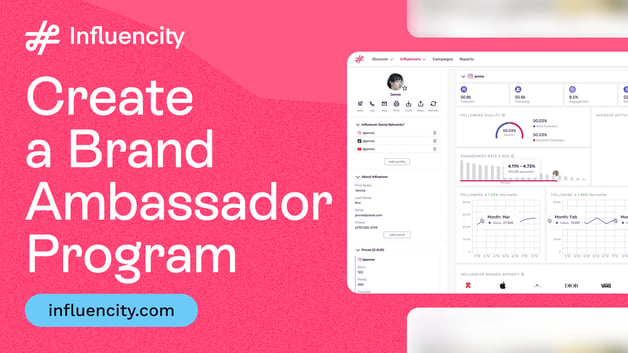How To Do an Influencer Profile Analysis with Influencity
Influencer partnerships can be a powerful lever for reaching new audiences and boosting brand awareness. But with countless influencers out there, finding the perfect fit for your campaign can be a challenge. That's where Influencity comes in! Our influencer marketing platform provides a wealth of data to support you in conducting an influencer profile analysis and identifying the ideal content creators for your brand.
This post will be your guide to unlocking the power of Influencity's profile analysis features. We'll delve into the platform's functionalities and explain how they can help you make informed, data-driven decisions that drive successful influencer marketing campaigns.
What Is an Influencer Profile Analysis?
An influencer profile analysis is a comprehensive evaluation of a social media influencer’s presence, audience, and performance metrics to assess their potential as a partner for an influencer marketing campaign.
This analysis helps brands and marketers understand various crucial aspects of an influencer’s profile, including but not limited to:
- Audience demographics. Analyzing who follows the influencer, including details like age, location, gender, and interests. This helps brands determine if the influencer’s audience aligns with their target market.
- Engagement metrics. Reviewing how the influencer’s audience interacts with their content. Metrics such as likes, comments, shares, and overall engagement rates provide insight into how compelling and influential the content is among followers.
- Content quality and relevance. Evaluating the quality, style, and type of content the influencer produces. This includes looking at how often they post, the consistency of their content, and how well it aligns with a brand's image or message.
- Reach and influence. Measuring the extent of the influencer’s reach, which includes not only the number of followers but also the spread and influence across different platforms.
- Past campaign performance. Examining previous partnerships and campaigns the influencer has been involved with, including the outcomes and any measurable ROI from these collaborations.
- Growth trends. Tracking the growth rate of the influencer’s followers and their social media presence over time to predict future influence and relevance.
- Authenticity and credibility. Assessing how genuine the influencer's interactions are and their reputation among their audience and within the industry. This includes checking for red flags like purchased followers or disproportionately low engagement rates.
In short, by conducting an influencer profile analysis, brands can make informed decisions about which influencers to collaborate with, ensuring a good fit that maximizes the chances of a successful influencer marketing campaign.
How To Conduct an Influencer Profile Analysis with Influencity
Now let’s get to the heart of this post: how to conduct an influencer profile analysis using the tools available through Influencity’s influencer marketing platform.
Set Up Your Influencity Account
Before diving into the analytics, you first need to set up an account with Influencity. Setting up an account with Influencity is really easy. Simply, sign up for a trial, enter your company's details, and that's it! Your account will be ready for you to start using. During the trial period, there is a limit to the number of profiles that you can analyse, but you can always buy one of our plans to analyze more profiles.
Conduct an Influencer Audience Analysis
The next step is to conduct a detailed influencer audience analysis. To do this, you just need to confirm the platform you are interested in and add the influencer’s handle to the search box to analyze the profile. The platform will then generate all the data you need to determine whether they might be a good fit for you. During this phase, pay close attention to influencers who not only meet the quantitative criteria but also embody the qualitative aspects that reflect your brand’s image and ethos. This is crucial for forming effective long-term influencer partnerships.
Specifically, you can do the following with this data:
- Review audience demographics: Check the age, location, gender, and interests of the influencer’s followers.
- Analyze engagement & performance metrics: Look at the likes, views, comments, Earned Media Value (EMV), and shares per post to gauge how actively engaged the audience is with the influencer’s content.
- Conduct in-depth analyses: Such as Follower Quality (fake followers), Audience Lookalikes, most used hashtags or mentions, and Audience Reachability..
Influencity provides these metrics and more in an easy-to-understand format, allowing you to quickly assess the compatibility of the influencer’s audience with your brand’s marketing objectives. You can access this data through your Influencer Relationship Management tool.
Here’s an example of the metrics you’ll see when you analyze an influencer's profile:
Analyze Content and Past Collaborations
Finally, after assessing the audience, focus on the influencer’s content quality and past performance metrics.
Influencity offers insights into:
- Content effectiveness. Analyze the relevance and quality of the influencer’s organic content based on your brand’s standards.
- Campaign performance. Review past collaborations the influencer has conducted, focusing on outcomes and ROI.
This step is vital for understanding how the influencer manages content. Additionally, you can use the platform to review historical data on the influencer’s growth. That way, you can determine if the profile’s following has grown or decreased significantly at any point. If it has, then you will need to do further analysis to determine why..
Generate Estimated Campaign Results
The next step is compiling all the data you have collected during your influencer profile analysis into actionable reports that summarize the influencer's potential for your brand. These reports should offer a holistic view of the influencer’s profile, including comprehensive summaries from your influencer audience analysis (highlighting key demographics and engagement metrics) and insights into content effectiveness and past campaign performances.
You can generate these reports directly from Influencity’s Campaign dashboard.
Initiate Contact and Build Partnerships
Finally, once you have completed your influencer profile analysis and selected the ideal candidates, the next step is to initiate contact and start building those all-important long-term influencer partnerships. You can do this through Influencity’s platform through the Outreach tool. Simply access the influencer’s profile and you’ll see the contact details you need to reach out.
You can also track all your communications directly from your dashboard. Plus, you will get access to a range of email marketing metrics, including opens, clicks, and delivery receipts. That way, you can maintain a clear and organized overview of all your interactions, and you will see who has opened your emails and chosen not to respond (for example). This integrated communication tracking feature not only simplifies the management process but also helps you build stronger, more productive relationships with your chosen influencers.
If you are interested in learning more about how Influencity can help you analyze influencer profiles then book a demo here.
Tags:






















%20and%20How%20Can%20They%20Benefit%20Your%20Brand%20article.jpg?length=628&name=What%20Are%20Key%20Opinion%20Leaders%20(KOL)%20and%20How%20Can%20They%20Benefit%20Your%20Brand%20article.jpg)








